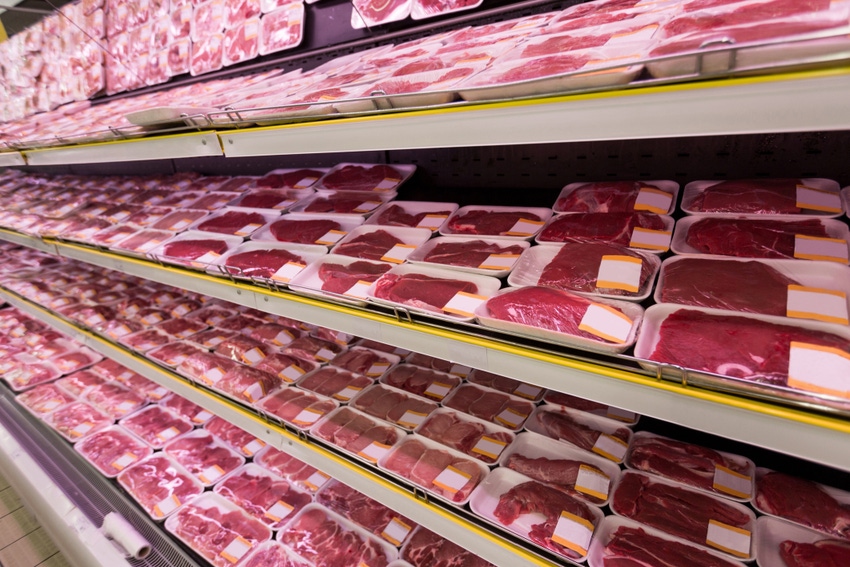Total meat sales have seen double-digit dollar gains for 24 consecutive weeks during pandemic.

Following the two massive stock-up weeks in mid-March, the frequency of consumer trips fell but spending, particularly on meat, has remained highly elevated for the subsequent five months.
The most recent IRI COVID-19 shopper impact survey, conducted August 7-9, revealed that there are finally some signs of easing for the stock-up trip behavior. Down from 41% in early July, 34% of shoppers say they remain focused on making fewer, larger groceries trips to minimize in-store visits. And down from 30%, now only 25% are stocking up on pantry staples/essentials more than usual. These changes go hand-in-hand with concerns over COVID-19 easing a bit, although 57% of the population remain extremely concerned down from a high of 60% in late June.
More districts have firmed up back-to-school plans, and the percentage of parents who say their children will follow online, at-home education reached yet another high, the latest IRI survey showed. Nearly 60% of parents with children ages six to 12 reported their children will follow at-home education only, with an additional 17% reporting the kids will follow a hybrid online and in-person format. Among parents with students ages 13 to 17, 52% reported their children will partake in virtual education only, with an additional 20% in the hybrid system.
Anne-Marie Roerink, president of 210 Analytics LLC, said this will likely affect trend lines of items popular for the breakfast, snack and lunch occasions.
“The net effect of these negative and positive forces resulted in continued high everyday demand for the meat department the third full week of August,” she said, adding that it was the seventh of eight non-holiday weeks between Independence Day and Labor Day.
Total meat sales have seen double-digit dollar gains for 24 consecutive weeks, with the latest week up 16.2% for the week ending August 23. Roerink said prices have continued to drop in favor of the consumer, leading to a 7.9% volume sales increase over the same week last year.
So far during the pandemic, from March 15 through August 23, dollar sales are up 31.7% and volume sales have increased 19.1% versus the same period last year. Roerink said this translates into an additional $8.6 billion in meat department sales, which includes an additional $4.0 billion for beef, $1.2 billion for chicken and $893 million for pork.
Christine McCracken, executive director of Food & Agribusiness for Rabobank, relayed that buyer interest in chicken has waned during the last final weeks of summer, with the possible exception of wings.
“Support for chicken wings from traditional and new wing takeout concepts, given the ease of preparation, is helping to support prices heading into the fall,” she said.
Overall, she expects to see retail support for beef, especially ribs and loins over the Labor Day holiday.
“With ample supplies of protein, consumers should have plenty of low-cost options.”
Majority of proteins see gains
According to Roerink, four-out-of-the-five fresh proteins had double-digit gains during the week ending August 23 compared to last year’s levels. Pork gains once more exceeded those of chicken while lamb took over as the highest growth area, percentage wise, she relayed.
Beef accounted for 51.3% of the $176 million in new meat department dollars during the week. At an increase of $90.4 million, beef’s additional dollars were more than five times that of chicken the week of August 23, that generated an increase of $16.4 million. Pork came in third for new dollars, at an increase of $11.8 million.
“Beef has been an astounding pandemic powerhouse with continued elevated dollar and volume shares compared with their March 1, pre-pandemic start,” Roerink said.
Pork had significantly higher shares a few months ago but is mostly back in line with prior levels, she reported, adding that chicken remains down in both dollar and volume share.
Antibiotic-related claims, organic and grass-fed claims have also seen unprecedented growth rates. During the March through July pandemic period, claims-based meat gained 31.9% in dollars. The highest gains were reserved for grass-fed beef, up 64.3%. Beef also led growth percentages in organic, up 57.9% and antibiotic-related claims, up60.6%. Chicken, which lost some market share amid the pandemic, also saw some softness in antibiotic-free claim sales, which led to a drop in share.
Roerink said meat sales, aided by the effect of virtual schooling, will likely to hold well above 2019 levels for the foreseeable future.
About the Author(s)
You May Also Like




.png?width=300&auto=webp&quality=80&disable=upscale)
